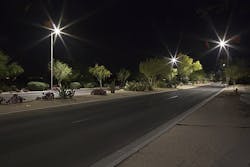Phoenix begins comprehensive LED street-light retrofit with GE Lighting
GE Lighting has announced an LED street light project with the city of Phoenix, AZ that will include conversion of 700 high-pressure sodium (HPS) lights to LEDs this year. The city is projecting 60% energy savings from the retrofit and plans to convert all 95,000 legacy fixtures in the city by 2020.
Ironically, the Illuminating Engineering Society (IES) Street and Area Lighting Conference (SALC) was held at a Phoenix resort in September 2013. At the conference opening, speakers from the city of Phoenix admitted that the city had yet to begin installing LED street lights, although the city had lit the short roadway to the resort entrance that hosted the event with LEDs just prior to the conference.
Indeed, Phoenix went through an unusually long test and evaluation period before choosing a street-light retrofit course of action. "We reviewed more than two dozen fixtures and conducted controlled testing for nearly four years to examine characteristics such as lighting patterns, overspill, and uplighting," said Jason Fernandez, principal engineer technician with the Phoenix Street Transportation Department.
The city worked with the Arizona Public Services (APS) utility on the project. APS led the field test portion of the project including installation and evaluation of five GE Evolve luminaires including ERS1 and ERS2 models. The city was especially concerned about the harsh operating environment and the fact that temperature extremes range to 105°F.
The evaluation led to GE being selected to supply fixtures for the broader project. "GE's Evolve LED street lighting is our new standard and will be installed anywhere a fixture needs to be replaced or where new construction and capital improvements occur," Fernandez said. "Additionally, with the energy and cost savings we experience from each new fixture, we're putting that money toward our investment for more LED street lights."
Specifically, the city is installing the GE Evolve LED Roadway Scalable Cobrahead fixtures. The scalable design is achieved via the number of LED light engines used to populate a fixture and results in the same basic design being applicable to a wide variety of roadway types. Oakland, CA recently announced plans to use the scalable family as well.
Phoenix is planning to convert 700 fixtures this year wth the upgrade already underway. That initial phase will deliver $57,000 annually in energy savings and $41,000 annually in maintenance savings. The city projects 11 years of maintenance-free usage based on 12-hour days and the 50,000-hour expected lifetime.
Ultimately, Phoenix plans to install LED lighting along 4800 miles of roadway by 2020. The project will encompass 95,000 LED fixtures.

Maury Wright | Editor in Chief
Maury Wright is an electronics engineer turned technology journalist, who has focused specifically on the LED & Lighting industry for the past decade. Wright first wrote for LEDs Magazine as a contractor in 2010, and took over as Editor-in-Chief in 2012. He has broad experience in technology areas ranging from microprocessors to digital media to wireless networks that he gained over 30 years in the trade press. Wright has experience running global editorial operations, such as during his tenure as worldwide editorial director of EDN Magazine, and has been instrumental in launching publication websites going back to the earliest days of the Internet. Wright has won numerous industry awards, including multiple ASBPE national awards for B2B journalism excellence, and has received finalist recognition for LEDs Magazine in the FOLIO Eddie Awards. He received a BS in electrical engineering from Auburn University.





